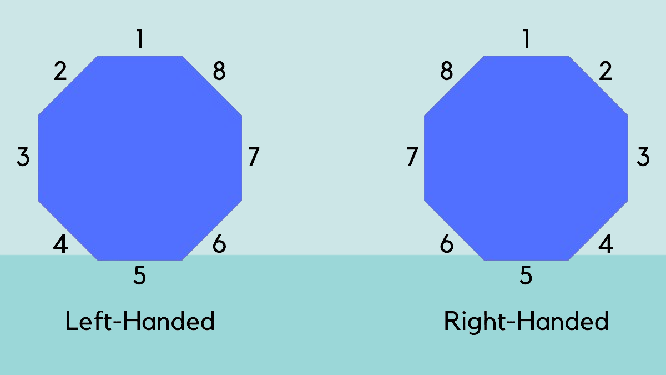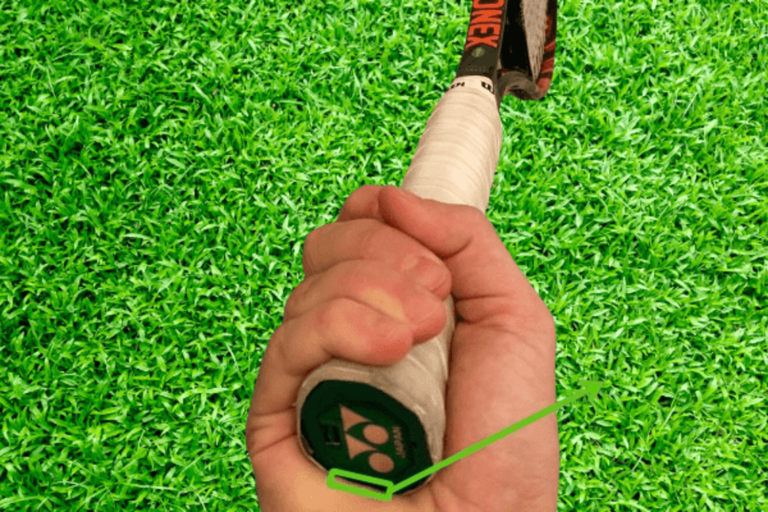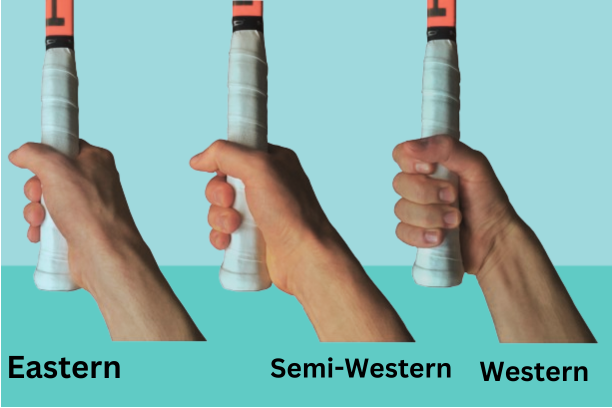The dimensions of the handle on a tennis racket refer to the Tennis Grips. The surface design, circumference, and Weight determine the shape of the handle. Other dimensions that determine the racket’s handle are its diameter, length, and width. In simple grip is a way of holding the tennis racket. There are Different Types Of Tennis Grips. Different Grips have different benefits and disadvantages.
Do you know the Different Types Of Tennis Grips? If you are a beginner and don’t know about Tennis Grips. Don’t worry, this blog post is only for you. At the end of this article, you will understand all about it. Let’s proceed towards our recent topic.
If you play tennis or taking an interest, it’s important to know the Types Of Tennis Grips. Then make an informed decision about it. We discuss Different Grips like Serve, Volley, and Forehand. All grips have different benefits and drawbacks. Tennis grips with equipment have changed in the modern era.
Table of Contents
ToggleHistory of Different Types Of Tennis Grips
The continental grip was often used in the sport’s early years. Wimbledon, the Australian Open, and the US Open were 3 major tennis events held on grass until 1974. Wooden rackets with natural gut strings were the standard.
The continental grip was perfect for catching balls that bounced below the waist. Because grass courts are the fastest surface type. They have a lower bounce than clay and synthetic.
Wood rackets, but, were the gold standard through the 1970s. F The continental grip was better because the players were able to control the ball.
As the sport developed, players’ fitness regimes increased and it grew more competitive. The introduction of polyester tennis strings is common for players. It can swing faster and produce more spin, which regulated power, in the 1990s.
Changes occurred in racket and string, and the decline of grass courts. First to emerge was the eastern forehand grip. Which encouraged more baseline play and simplified the process of producing topspin. Despite having existed since the 1920s, it didn’t gain popularity. Then Bjorn Borg’s breakthrough in the 1970s helped make it more accepted.
In the 1980s, players like Andrea Agassi used the semi-western grip. He played from the baseline, which helped the grip gain popularity. But, players continued to adopt the Western grip and, the uncommon Hawaiian grip. Today continental grip plays a vital role in tennis racket.
How can Hold a Tennis Racket?
Four grips are present on a tennis racket. The most common is the eastern, semi-western, western, and continental grips. Every grip has advantages and disadvantages. Your choice of grip has a significant impact on how you approach the game. Watch this video to see the holding way of the racket.
Why do Use Overgrip tape?
Before we get into the particular tennis grips, let’s talk about overgrip tapes. Tennis overgrip tape increases comfort and grip on the racket handle. It provides a stable, solid grip even in sweaty situations. It cushions to lower the chance of hand blisters during long play.
Better control and accuracy result from this with each shot. The range of colors and patterns it comes in offers a customized look to your racket. Any players who want to improve their game should have overgrip tape.
Different Types Of Tennis Grips
- Forehand
- Slice forehand
- One-handed backhand
- Two-handed backhand
- Slice backhand
- Serve
- Volleys
- Overheads
- Hawaiian Grip

Forehand Grips
Forehand grips are of different types like continental, eastern, western, and semi.
Semi-Western forehand grip (Bevel - 4)
This grip closes the racket face upon contact, allowing for more topspin. It allows for superb topspin and quick grip adjustments. The semi-western grip sits between the eastern and western grips. It has become the most popular forehand tennis grip in modern tennis.
Martina Hingis and Andre Agassi used this grip throughout the 1990s and early 2000s. But in the modern era, Novak Djokovic and Serena Williams use this.
Advantages
- Outstanding topspin
- Rapid grip changes
- Perfect for all-court and baseline play
- Excellent protection against balls with increased bounce
- Effective on all court surfaces
Disadvantages
- Difficult with low balls
Formation of Semi-Western forehand grip
If you are right-handed, place the palm side of your index bottom knuckle against the bevel 4. If you are lefty place it against the bevel 6 to form the semi-western grip.
Next, place the handle of the racket at the base of your palm.
Western Forehand Grip (Bevel -4)
One of the extreme grips used to produce topspin is the Western Forehand Grip. It goes one step farther than the semi-western and lets players produce good topspin. The heel is on the Western side and the knuckle is on the Semi-Western bevel 4.
Many players from Europe and Latin America, where clay courts are common, use the Western grip. It is also used by many players on the professional tour. The ball bounces higher on clay, which is the slowest court surface. More severe grips stress this higher bounce and topspin.
Many players find it a touch too severe, but a few tour-level players use it. It challenging to hit a forehand with this grip at the basic level.

Advantages
- High topspin
- Performs well on slower tennis courts
- Perfect for playing from the baseline
- Ideal for balls that bounce high
Disadvantages
- Difficult to switch grips fast
- Challenging for novices to learn
- Difficult to handle low shots that force players to extend beyond their Strike zone
Formation of Western grip
Whether you are right- or lefty align the palm side of the index knuckle with bevel 5. which is the midway point around the handle, to form the western grip.
Next, place the handle of the racket at the base of your palm. Then encircle it with your fingers.
Hawaiian Grip Tennis Grip
It is the extreme-western Tennis Grip. Hawaiian grip is not used more.It has the negative aspects of the Western grip, only accentuated. Players find it tricky to flatten out and drive the ball, which is still difficult.
Topspin is helpful, but to compete at higher levels of the sport. Players must be able to hit through their opponent and make shots.
Advantages
- High levels of topspin
Disadvantages
- Difficult to switch grips
- Difficult for beginners to learn
- Increased chance of injury
- Tough to drive the ball and play
Formation of Huwain Tennis Grips
Put the palm side of the index bottom knuckle against the bevel 4 if you’re lefty. Or place it on the 6th bevel if you’re right-handed. Next, place the handle of the racket at the base of your palm.
Continental Forehand Grip (Bevel - 2)
It’s called “the Shotgun” grip. Its strange style of attack and pressure on the ball are the cause of this. For enough effect, the grip is always placed close to the racket shaft. As a result, the racket will strike the ball with high force, much to a shotgun. Thus the name is shotgun”.
The Continental Forehand Tennis Grips dominated competitive tennis in its early years. We discussed it in the history section of Tennis Grips. Continental Forehand Grip has remained vanish from the forehands.

Advantages
- Simple to manage balls with low bounce
- For other shots, little to no grip change is necessary
Disadvantages
- Absence of topspin
- Reduced capacity for power
- Having trouble controlling bouncy balls
Formation Of Continental Forehand Grip
If you are lefty put the palm side of your index finger’s bottom knuckle on bevel 2. Put it on bevel 8 if you’re right-handed to create the continental grip. Next, place the racket handle’s butt at the palm base.
Eastern Forehand Grip
Flatter groundstrokes are the main use for the Eastern Forehand Grip. To perform an Eastern Forehand Grip place the heel pad and index knuckle on the bevel – 3.
To get an Eastern forehand, it’s simple to apply this technique. Place the palm flat against the strings, sliding down to the handle, and grabbing. When hard courts replaced grass courts in the Eastern U.S. gained popularity. Because the balls bounced higher on the harder surface. Roger Federer and Juan Martin Del Potro use the Eastern Forehand Grip.
Advantages
- Fast grip changes, perfect for volleying and serving
- enough creation of topspin
- performs well on quicker court surfaces
- simpler to understand for beginners
Disadvantages
- Compared to Western contemporaries, less topspin
- Having trouble controlling balls that bounce higher
- Not the best for assertive baseline play
Formation of Eastern Forehand Grip
To form an Eastern Forehand Grip press the palm side of the index finger. Place the bottom knuckle against either the 3rd or the 7th bevel. Next, place the handle of the racket at the base of your palm.
Backhand Tennis Grips
Players must improve their backhand to become dependable and ideal. Backhand is a weapon to compete at the greatest levels. A weak backhand makes you a target for your opponents to exploit.
Since the backhand shot necessitates hitting across your body. Many players find it difficult, and most players have had less success with it.Today backhand is as deadly and dependable as forehand Tennis Grips.
Types of backhand grips
- Two-handed backhand
- One-handed backhand
Two-handed backhand Tennis Grips
The two-handed backhand didn’t take off until the 1970s. Players like Chris Evert, Jimmy Connors, and Bjorn Borg were well-known at that time. The two-handed backhand is currently the most used.
Almost 88% of the top 100 male and female players use two-handed. On the women’s side, that percentage rises to 97%. Since they lack the muscle and coordination to hit with one hand.
Advantages
- simpler to understand
- Increased command
- Extra strength
Disadvantages
- Restricts a player’s reach for shots that take them much outside of their striking zone
One-handed Tennis Grips
Players on the ATP and WTA Tour continue to use the one-handed topspin. On the men’s side, more players are using it to compete at the greatest game. Grigor Dimitrov, Stan Wawrinka, Roger Federer, and Dominic Thiem use it. Rising talents like Stefanos Tsitsipas and Denis Shapovalov also prefer one-handed.
The one-handed backhand is now used by 5 of the top 20 men’s players. But not a single player in the top 50 women’s players uses it.
When a player’s coordination and skill level are down, they start two-handed.
Advantages
- increased control
Disadvantages
- The high learning curve in most cases
- Needs coordination and strength.
- Challenges in getting back serve
- Higher balls are more difficult to manage
- Show a wide stance with difficulty
Serve, Volley, Slice, Overhead Grip
Continental Tennis Grips are less common but still useful for several other crucial shots, such as:
- Serve
- Forehand volley
- Backhand volley
- Half volley
- Slice forehand
- Slice backhand
- Overhead
- Drop shot
Yes, you can use the same grip for all these and don’t have to switch it up when switching between them. It’s also one of the few grips that coaches and players believe is the best for all these shots.Tennis
How to Select a Grip?
There are distinct Tennis Grips for the forehand and backhand of a player. To select the best players and Coaches should try new things.
Most players find that certain grips work well but it’s a narrow perspective. When asked in an interview why he preferred to use a one-handed backhand? Federer’s reaction was simple, it didn’t feel natural. Federer and Nadal show this point that players can succeed with different grips.
Recommended Tennis Grips
These are our suggestions if you’re unsure of where to begin and need guidance on which grips to use:
- Forehand – Semi-western
- Backend – Two-handed
- Serve; Continental, in volleys, slices, etc.
These grips will work well for many players but don’t limit yourself to using them. Try some other ones instead. It’s very simple to explore.
Conclusion
In conclusion, different players use different Tennis Grips. Some players use Eastern, some Western, and some continental. In a certain period, continental was dominant. In the next period, Eastern and Western were dominant. Tennis Grips are the most important factor in winning. Selection of the best grip is also crucial.
The western grip is a forehand grip used to produce topspin. The semi-western grip sits between the eastern and western grips. It has become the most popular forehand tennis grip in modern tennis. Flatter groundstrokes are the main use for the Eastern Forehand Grip. Almost 88% of the top 100 male and female players use two-handed. On the women’s side, that percentage rises to 97%.

